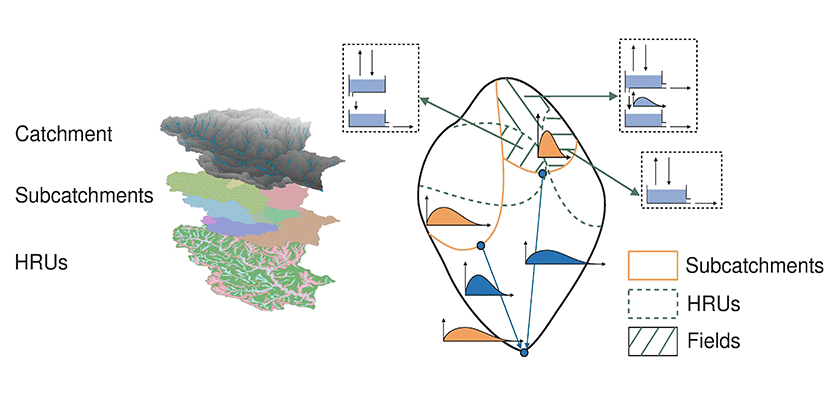Department Systems Analysis, Integrated Assessment and Modelling
SUPERFLEX

SUPERFLEX is a flexible framework for building models from generic components intended to represent distinct hydrological functions at the catchment scale. Within this framework, model structures are hypothesized and constructed using generic components such as reservoirs and lag functions, assembled (connected) into a coupled system model using junctions and fluxes, and parameterized using constitutive functions relating internal states and fluxes. Importantly, all model components are built with attention toward important mathematical aspects of model design, including the use of robust numerical approximations and numerically smooth constitutive functions (even when representing threshold behavior). This prevents avoidable numerical artifacts from corrupting the model equations and obscuring the model analysis, interpretation, and predictive use.
SUPERFLEX aims to organize and systematize the fragmented field of conceptual modeling and provides a platform for more systematic and robust hypothesis testing. In addition to its ability to reproduce many existing models within a single mathematically consistent and robust framework, a flexible framework can be used to generate a large variety of alternative hypotheses describing different catchment functions and their connectivities within the overall system architecture.
Importantly, by operating within a single framework, hypothesis testing can proceed unobscured by uncontrolled and/or unaccounted differences in overall model philosophy and/or component implementation and software, all of which can arise when simply combining together disparate and separately developed process modules. In more pragmatic applications, the flexibility of the framework permits tailoring, in a controlled way, specific model configurations to specific modeling contexts (e.g., specific catchments, specific data availability, etc.).
References:
Fenicia, F., D. Kavetski, and H. H. G. Savenije (2011), Elements of a flexible approach for conceptual hydrological modeling: 1. Motivation and theoretical development, Water Resources Research, 47(11), W11510, 10.1029/2010wr010174.
Kavetski, D., F. Fenicia, and M. P. Clark (2011), Impact of temporal data resolution on parameter inference and model identification in conceptual hydrological modeling: Insights from an experimental catchment, Water Resources Research, 47(5), W05501, 10.1029/2010wr009525.

